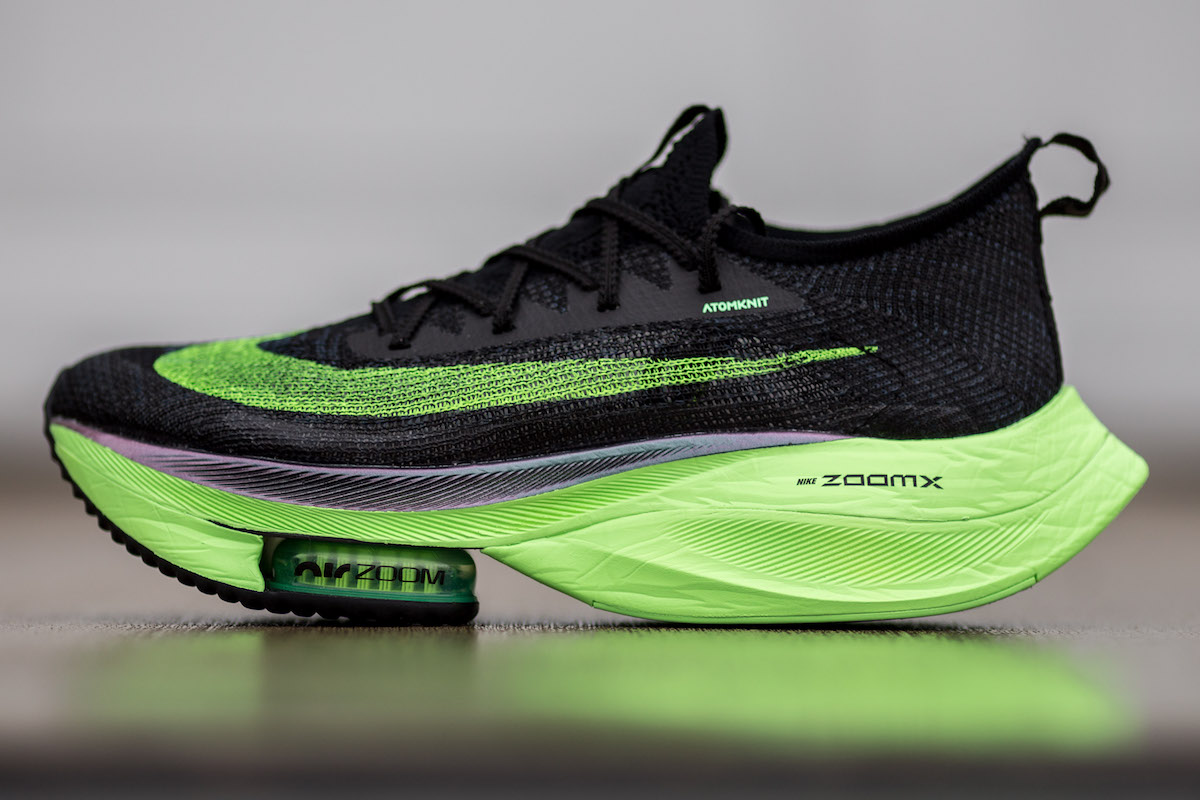
BEN: While Nike and Eliud Kipchoge failed to break the 2-hour marathon milestone in Monza for the original Breaking2 project, the drive to achieve the goal remained. Leading up to a second attempt this past fall in Austria (at the INEOS 1:59 Challenge), Kipchoge and Nike continued to work on the shoe development portion of the equation. The outcome of this was a 1:59:40 marathon and the debut of the newest marathon shoe from Nike: the Air Zoom Alphafly NEXT%.
But first, let’s rewind: It’d be an understatement to say the running shoe game changed when Nike unveiled the first iteration of the Nike Vaporfly 4% during that first Breaking2 project. It certainly raised some eyebrows with its shocking stack height and unconventional design.
The shoe has seen an evolution since then, moving from the Vaporfly 4% Flyknit to the Vaporfly NEXT%, and finally, the Air Zoom Alphafly NEXT%. At the core of all these shoes is the innovative combination of lightweight Pebax foam (Zoom X) and a curved carbon fiber plate. Nike’s cutting-edge design and materials in an ultra-lightweight package has made the shoe a game changer in the marathon racing world– both at the professional level, and for everyday runners like the rest of us. Just look at the start line of any marathon, and you’ll see a crowd awash in the neon colorways of the NEXT%, and soon, the black and green of the Alphafly. Other shoe companies have been attempting to catch up ever since.
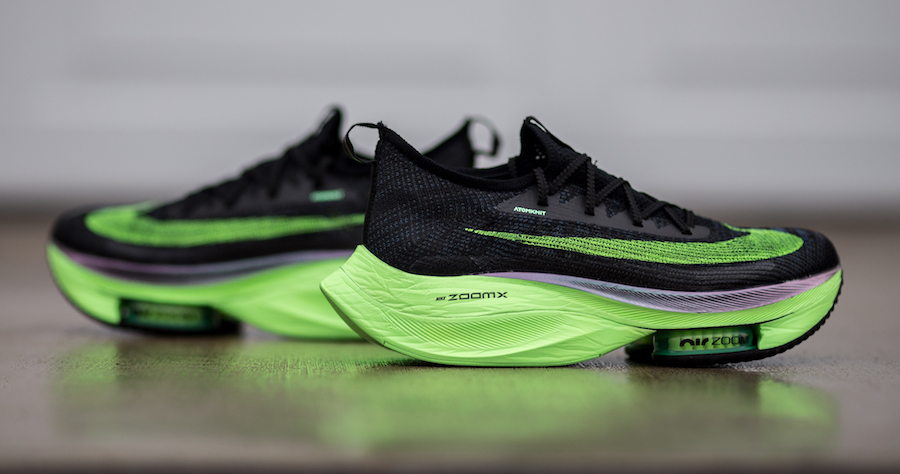
However, it almost didn’t happen. Or so, most runners thought. In the months after the INEOS 1:59 event, there was considerable controversy about whether Kipchoge’s prototype shoe (an early version of the Alphafly) would be “banned” from competition. Runners waited tentatively to see if World Athletics (the rule-makers of the sport) would come down with a ruling prior to the U.S. Olympic Marathon Trials. On January 31st, 2020 new regulations were announced. At first, speculation abounded– there was no way Nike’s newest shoe would fit under the 40 mm stack height specified in the ruling. However, shortly thereafter Nike confirmed that the Alphafly met these requirements (barely) and would be released to the public on February 29, the same day as the Trials. While I won’t go into all the minor details and repercussions of the decision, Robbe has written some great articles documenting this saga (even before the Alphafly was officially announced):
In addition to the “limited release” on February 29, Nike also released the Alphafly to all athletes competing in the U.S. Olympic Marathon Trials marathon in Atlanta on the same day. To demonstrate how confident they were, and to ensure there were no arguments regarding “fairness” of a Nike athlete having a shoe that was not widely available, they gave every single runner a free pair. Honestly, it was a genius marketing move.
So anyway, let’s get to a shoe review. Starting with the specs. Compared to the Vaporfly NEXT% the Alphafly is slightly heavier, but adds a lot more cushioning- and air! Good ol’ Nike Air. The shoe retains the single, curved, carbon fiber plate and the full ZoomX foam midsole. But it also adds two side-by-side Zoom Air pods under each foot. The pods reside below the carbon plate, and just above the outsole.
Jamming all of these components into a midsole has resulted in an incremental growth in midsole thickness. Despite looking taller than a pair of stilts, they still meet the regulated thickness of 40 mm (measured in the heel on a size 8.5M US). The other applicable regulation is the must only have a single plate within the shoe (which it does, contrary to our original article referencing a variety of Nike patents in an attempt to identify Kipchoge’s prototype shoe). All that to say, this shoe is legal.
The midsole got a majorly new look, but so did the upper– or did it? The upper is completely different than the VaporWeave found on the Vaporfly NEXT%, but actually looks quite similar to the Flyknit seen on the prior Vaporfly (and other Nike shoes). But this upper is not Flyknit. It’s Atomknit. Think Flyknit to the extreme. It’s lighter and it’s more breathable, but it’s way less stretchy.
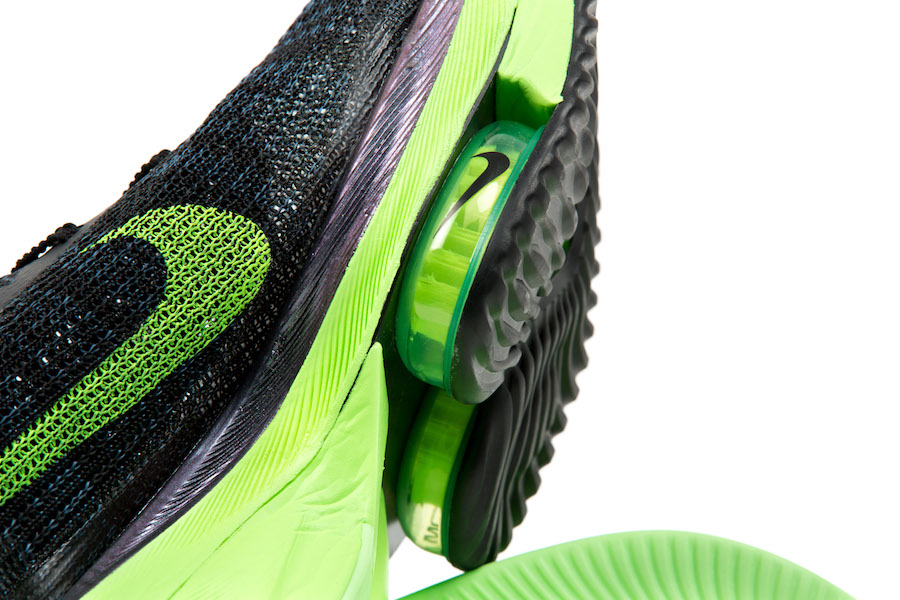
BEN: All right, so what does it all mean? For starters, the shoe looks completely different. It’s like nothing before it. It makes the previously crazy-looking Vaporfly Next% somehow now look normal. If you can get beyond the non-traditional appearance (or maybe that’s your favorite part about it) you’ll find a shoe that’s still quite light, still as fast as ever, and manages to have even more cushion.
The first step to experiencing all of this goodness is to get it on your foot. Meaning, the Atomknit doesn’t stretch. Jamming your foot into the shoe for the first time is quite an adventure. Luckily the shoe has two pull tabs because you’ll need them. Don’t be timid, just go for it. Once you’re in you’ll find the fit is similarly narrow through the midfoot (like prior Vaporfly models), but the forefoot is noticeably roomier. It is both wider and taller. The Atomknit is more structured in the toes than either Flyknit or VaporWeave so it leaves a lot more vertical space.
I find the shoe fits true to size in every way and I love the fit. I have a wider forefoot and the extra space works great for me. The upper hugs the foot like a glove and the laces are now “ribbed” and stay tied very well. Compared to the somewhat finicky lace-up experience of the Vaporfly NEXT%, this is much quicker and easier. I still find the shoe has a prominent arch (like prior Vaporfly models). This is noticeable when putting on the shoe, but not bothersome while running.
Enough about uppers– how does it run? Amazingly.
The bounce and cushion of this shoe is just off the charts. It takes what the Vaporfly did and turns it up. All of the speed and efficiency you’re used to from the ZoomX foam and carbon plate is still there, but there’s more of it and there are massive Zoom Air pods directly underfoot. One of Kipchoge’s requests was continued reduction in impact forces as the shoe was developed. As anyone knows, the GOAT gets what he wants. And this shoe does it, filling every nook and cranny of the WA regulations.

Being able to run at race pace for a long duration while not having feet that feel like they were pummeled in a game of whack-a-mole is quite the combination. The added cushion of this shoe really helps ensure that impact-related fatigue will not be a limiting factor in your training or racing. And it manages to do it without losing any of the response or turnover that was seen in the Vaporfly.
I currently have over 175 miles on my pair, and I’ve run the full marathon distance in them twice. The first was a 2:57 in April, and the second was a recent effort at the end of May at 2:44. This was a solo time trial but represents a significant improvement from my marathon PR of 2:52 from last year (ran in the Vaporfly NEXT%). In addition to the marathon distance, I’ve taken this shoe out for PR’s in everything from the half marathon down to the mile. I find that it’s plenty capable of going fast, as well as going long.
Sure, I’ve trained more, and my fitness is better, but the shoe does not disappoint. I definitely don’t claim the shoe is going to shave minutes off a marathon PR, but its ability to go the distance and leave my legs feeling fresh and ready to run the next day is unmatched. I find the fit and lockdown to be superb in this shoe with almost no adjustments needed. The knit upper and semi-circle heel pad (similar to the Vaporfly NEXT%) work perfectly. Comfort during the run and soreness (or lack of) afterward are incredible in the Alphafly.
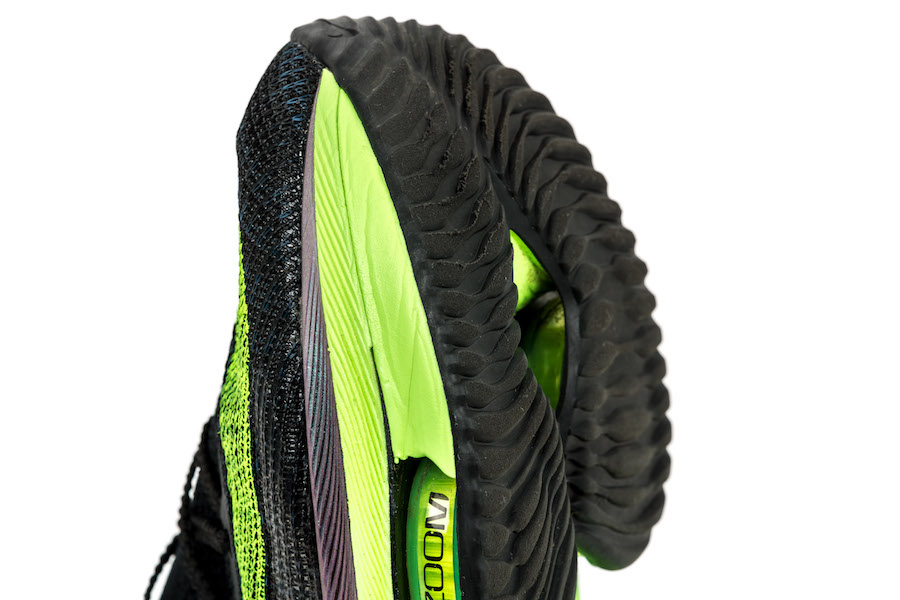
BEN: It’s a great shoe, but nothing is perfect. None of these are even close to a deal-breaker for me, but they’re “watch outs” worth mentioning. The first, and most obvious, is the weight. It’s gone up. In racing shoes, this is almost never seen, but the intention is that the added cushion is worth the weight penalty. For me, for the longer races, I completely agree. For a lighter or faster runner, I can definitely see instances where the case could be made for a less chunky shoe (even for the marathon, but increasingly more as the race distance decreases). Personally, I’d pick the Alphafly over the NEXT%, no questions asked, for 10K and up (tbh, I’d probably pick it for most shorter distances too, but could be convinced otherwise).
Next up is the midsole geometry. It’s a huge stack of stuff under your foot. In trying to get a much cushion in there as possible, the end result is a platform, and a nearly flat one. The drop has continually decreased in the Vaporfly as more cushion is put under the forefoot. This version is down to a 4 mm heel-to-toe drop. Much less than the shoes I typically run in. As someone who has had an Achilles injury, this is quite concerning, but so far hasn’t caused me any issues. In the same way, that geometry results in the shoe being an ankle-rolling hazard. I find the foam shape and firmness results in stability that’s on par or better than the Vaporfly NEXT%, but if you do roll it, it’s going to feel far worse due to the added height.
The last item of note is somewhat of a good news/bad news situation. The outsole now has a lot more physical features (grooves/ribs) that grip the road (any type of surface) much better than any prior Vaporfly. But these ribs are prone to visible wear. After nearly 200 miles some of mine are worn basically flat. There’s still plenty of rubber before going to bare foam, but the ribs are no longer there. I’d say this is no worse than the traction (or lack of) in the Vaporfly 4% when brand new, and the other big news is that the foam’s responsiveness seems to be holding up much better at this mileage than the Vaporfly (the Zoom Air is probably helping). I’m confident that the overall life of the Alphafly will be far greater than any prior Vaporfly.
I suppose it’s also worth mentioning the price. Yes, it’s the most expensive running shoe. No, I don’t expect that to change.
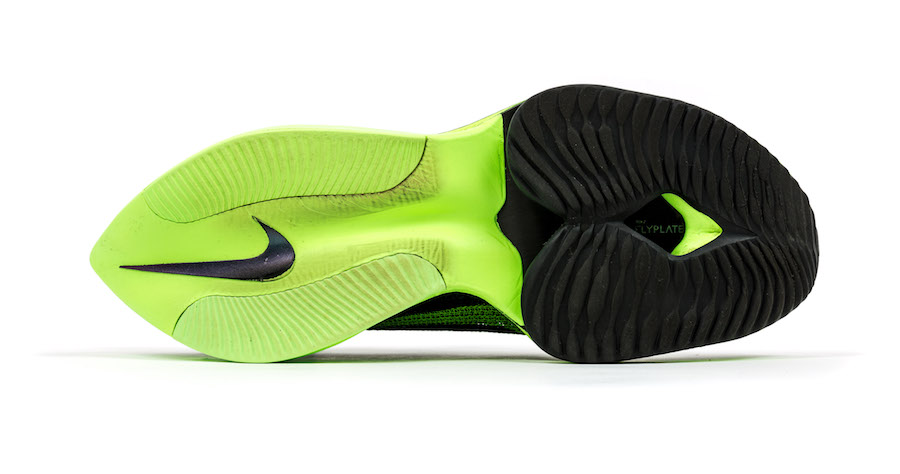
BEN: The Alphafly owns the only sub-2 hour marathon time ever recorded, but is it right for you? For me, the answer is a confident yes, and I think that will be the case for many other runners, with many different goals. The look can be a bit polarizing, but even if you hate the aesthetic, you’ll love the feeling on foot. It’s gotten a little chunkier, but the benefits are worth the weight. It has a big reputation to live up to, but I believe it does that and builds on it. The top shoe of the year for me (so far, anyway), and I expect to see it filling the starting corrals of races in the fall/winter/spring/whenever those happen again.
The Nike Air Zoom Alphafly NEXT% arrives in wide release on July 2, but will be available to Nike Plus members for preorder in the near future.
Have something to say? Leave a Comment
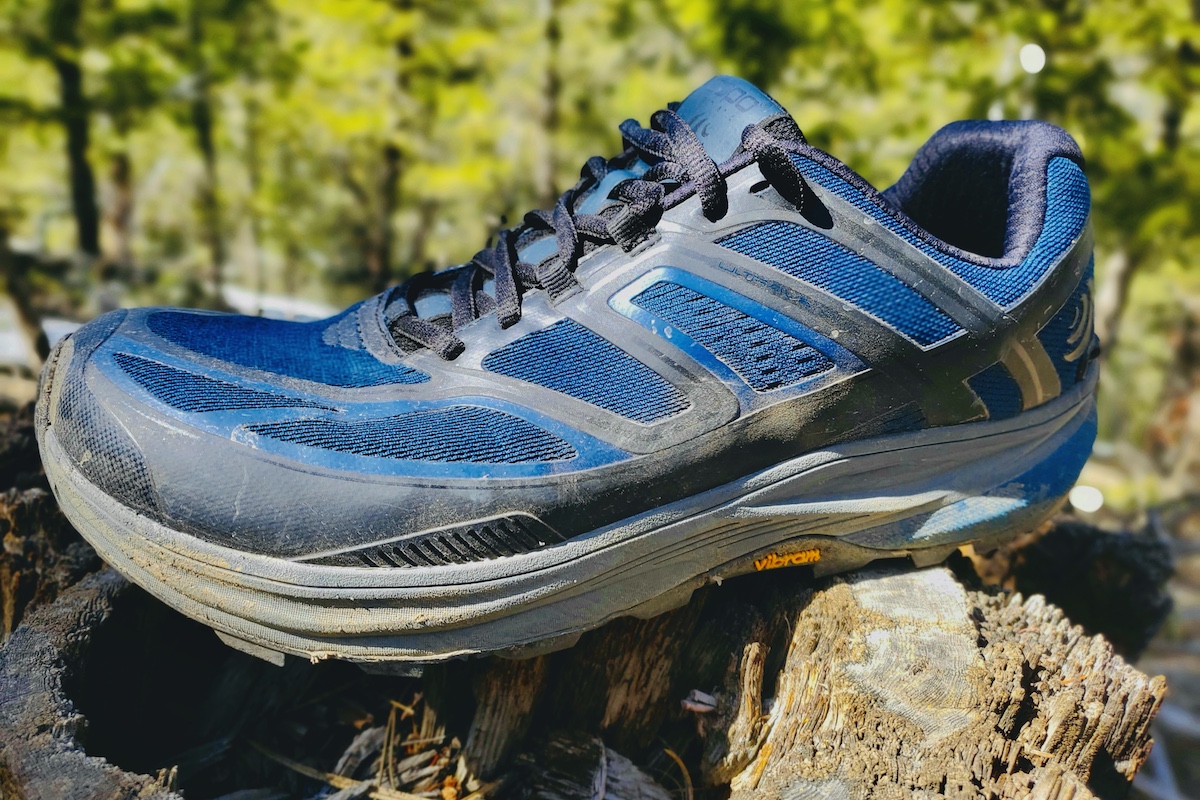

Great review. I recently discovered Ben and Believe In The Run independent of each other and I’m happy to see the collaboration.
As a flat footed guy, is this a no-go? Does Saucony’s Endorphin Pro have a less pronounced arch than these?
The Endorphin Pro is a beautiful shoe as well. And no pronounced arch but the plate does put you up on your toes, no doubt. It’s an incredible shoe.
Most people think World Athletics choose to measure the odd size 8.5 due to collusion with Nike. Most men will have quite a bit more the 40mm stack with these. Cheaterfly!
Lightning How so? World athletics measures and weighs your shoes if the race is eligible for a world record time or prize money?? Didnt you see the Tokyo marathon 2020?? The runners had to take their shoes off and give them to race officials for weight and measurement. This is only for the worlds top marathoners. If you run the marathon in 4-5 hours I’m not sure if they check your shoes as you would not be winning money or breaking records with those times.
How could you call a shoe cheaterfly?? If it’s good, Its good. Easy as 1,2,3….
Also mens size 8.5 is the most common shoe size worldwide. For men in the USA it’s a size 9.
I don’t know what you saw, but there is no weight limit for shoes and the stack height isn’t measured after races. The stack height limit is 40 mm for a Euro 42 sample size, which is equivalent to US men’s 8.5 and UK men’s 7.5 or 8. The usual sample size in the shoe industry is US men’s 9. The stack height is allowed to be greater than 40 mm for shoe sizes larger than Euro 42, so there is way to enforce the rule by measuring after a race.
The Alphafly just happened to check in at 39.5 mm for size Euro 42 days after the 40 mm limit was announced. Like I said before, Kipchoge’s size US men’s 10.5 was 45 mm. That 39.5 mm measurement just under the 40 mm limit for the smaller than in usual sample size and the quick announcement that the Alphafly was legal when most expected it not to be due to known stack height greater than 40 mm had most watchers suspecting collusion between Nike and World Athletics.
*there is no way to enforce the rule by measuring after a race.
The shoe is legal now. The Cheaterfly is reference partly to how the rules were crafted to make it legal.
World Athletics stated that the Alphafly Next% (or all new shoes for that matter) had to be “available to the public” in order to be legal. Nike “soft-launched” the shoe on February 29, and launched it July 2nd – both times selling out in less than 5 minutes. Nike has as of now (7.15.2020) removed the shoe from their online shop (at first it just said “sold out”). Does this count as being “available to the public”?
It definitely still counts. It was widely available to the public, doesn’t matter if it sold out or not. Trust us, Nike has their ducks in a row. Of course, none of this really matters since the Olympics are postponed.